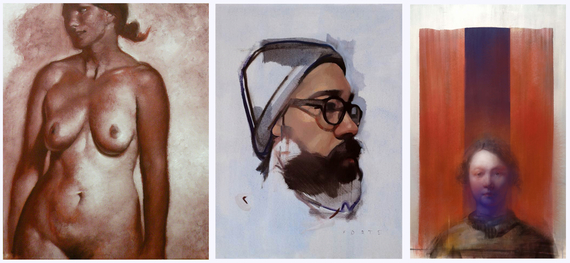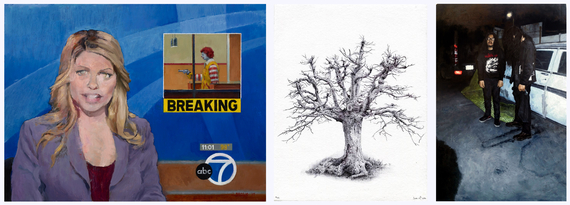If you've been following my last three Huffington Post blogs, you know that I've been teaching a class related to the production and dissemination of artworks online, especially on Facebook and Instagram. Or I should say that the undergrads in my class are teaching me. Their generation grew up in a tight relationship with computer technology and have experienced an alternate existence through the glowing 'screen' that I can only vaguely fathom.
There is much skepticism amongst older generations of artists as to whether the presentation of one's works online brings anything worthwhile to an art career, and a special disdain is reserved for the idea that art can be sold through Instagram. One hears rumors of success, but looking at the low price points of art offered through Instagram one wonders how these young artists ever pull in enough cash to pay the rent. The low prices probably reflect the fact that a large percentage of an artist's 'followers' are other artists. Many of them want to collect work, but can't afford to spend more than 500 dollars to do it.
To my colleagues who remain skeptical I hate to inform you that I think Instagram works as a platform for successful career opportunities and even sales. Ever since I realized I would be teaching this Internet class my mind has been preoccupied with all things Instagram. I don't like the platform at all, but also realize that it is great at getting more recognition and that young artists use it as their main source of knowledge about art and the art world. Due to its popularity and its limitations I also think Instagram is changing art and the kind of work that artists produce, so I thought an exhibition that explored this idea might be intriguing.
I approached Q Art Salon in Santa Ana with a plan to exhibit 25 to 30 artists with an active presence on Instagram. I wanted a third of them to be Instagram 'Stars' with a zillion followers. Another third would be Old Schoolers like myself, posting regularly but a little bit like fish out of water. The final third would be students from my Making Art in the Internet Age class, highly trained representational artists who look at and use Instagram constantly, and have huge choices to make about where they want their art to go. Q Art Salon went for the idea and we titled it #INSTALARITY.
In choosing the Instagram Stars my curatorial expertise consisted of me asking the young folks I know what artists they liked on Instagram, then I went after those with the highest number of followers. What I quickly discovered was that those with over 100 thousand followers were booked solid for two years and didn't even have small works to lend. I only got one to commit. It seems that a large Instagram following does equate to exhibitions and thus to potential sales. I hear of ever more galleries that select artists because of their large social media presence. They hope to piggyback on the artists' popularity and generate business accordingly.
In requesting works from those with 50 thousand followers or more my success rate was about fifty percent. Below that most said yes. I chose the Old Schoolers after observing their online activities over the last couple of years. Like me they post regularly now, but are slow to give up some of the cherished ideals inherent in their art educations: complexity in compositions, the tactility of paint, extreme subtlety in tone or color. These things can be lost on the little screen, where the default Instagram format is a little square of light the size of a playing card that favors centrality and symmetry, single objects or figures, complementary color choices, and strong tonal contrast.
This isn't to say that those artists most popular on Instagram can't or don't have it both ways. Most in this show do. But between the limitations of the format and the growing influence of social media popularity in choosing which artists fill gallery spaces, we are going to see ever more art that bears the hallmarks of the Instagram aesthetic. In pursuing their budding careers my students will have to decide how much that popular aesthetic is allowed to rule their artistic expression, and when and how to break away from the tyranny of "Likes" and the dopamine-rich adoration of thousands of followers.
#INSTALARITY runs at Q Art Salon in Santa Ana, California, from November 5 thru November 28, 2016. The artists are: @alonsaguevara, @artistkimberlyb, @charlieantolin, @damianchavezart, @danielmaidman, @dannygalieote, @dinabrodsky, @feliciaforte, @fscotthess, @georgedawnay, @gunopark, @jamesthistlethwaite, @jh_christine_lee, @johnbrosioart, @justin_tecson20, @lolagil, @marc_dalessio, @marctrujillo, @mariakreyn, @michellelynndoll, @nataliafabia, @ninaulett, @pottaytertots, @shannonfody, @stephenwrightpaintings, @valeriepeee, @visnrivera, @william_wray, @yalda_sepahpour, @zoeyfrank







